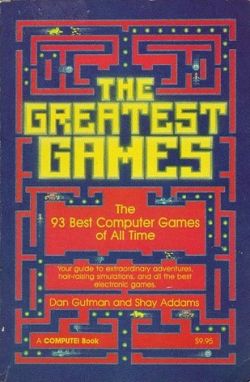 More than 70 Best Games lists have been used to create the Video Game Canon’s Top 1000 (with the oldest going all the way back to 1995). But did you know that an even earlier generation of writers were compiling notable lists in the 1980s?
More than 70 Best Games lists have been used to create the Video Game Canon’s Top 1000 (with the oldest going all the way back to 1995). But did you know that an even earlier generation of writers were compiling notable lists in the 1980s?
It’s true. People were already having fierce debates about which games should be considered the Best Games of All Time, even though we were just a decade removed from the launch of Computer Space.
Dan Gutman and Shay Addams, the editors of Computer Games magazine, were two writers who wanted to try their hand at creating just such a list. Branching out from their day jobs, the pair took their gaming expertise to Compute! Books, who agreed to publish The Greatest Games: The 93 Best Computer Games of All Time in January 1985.
The Greatest Games first appeared in bookstores during a very strange time for the industry. This was just after “The Great Video Game Crash” of 1983 marked the end of the line for the Atari 2600. But it was also a time when players were migrating over to a growing number of different computer platforms (especially outside the United States). You also have to remember what was still to come, as the book was published before Street Fighter II revitalized the arcade scene, before Tetris escaped the USSR, and before the NES changed everything.
So what were a couple of video game experts talking about as the best games ever in the 1980s?
I feel like I’m not properly equipped to talk about most of the titles from The Greatest Games, as few have any kind of online footprint, and even fewer have received a modern re-release. Thankfully, Gutman and Addams provide plenty of insight into several dozen games (and whole genres) that you don’t hear much about anymore. Among its 97 total entries (there are four double picks), 63 titles from the list are brand new to the Video Game Canon, including the very first game from LucasArts (Rescue on Fractalus) and a huge number of forgotten gems from the catalogs of companies like Infocom (Cutthroats, Deadline, and Planetfall) and Broderbund (The Arcade Machine, MasterType, and Spare Change).
That said, you’ll also find most of the obvious titles from the era, including Nintendo’s Donkey Kong, Namco’s Pac-Man, and Konami’s Frogger. For all the obscure alleyways the authors explore, it shouldn’t be too surprising that the games that have stood the test of time were always considered great.
Placing a heavy emphasis on adventure, puzzle, and strategy games, Gutman and Addams also wanted readers to know that the best games were some of the most mature games. Ahead of a section about chess and trivia games, the authors wrote, “Computer games have grown up.” And rather than give Pong an honorary mention as many listmakers do today, Gutman and Addams went after the Atari classic, beginning the Foreward with a declaration that “Computer [games have] come a long way since the days of Pong.”
It makes you wonder, were they the first to say that?
While the list itself is interesting, the story of what was happening around The Greatest Games might be even wilder, as several major figures from pop culture crossed paths on the way to the book’s creation. Computer Games magazine was started by Charles “Chip” Goodman in 1982 as Video Games Player. Goodman had publishing in his genes, as his father was Martin Goodman, who founded Timely Comics in the 1940s. You might know it better by its current name, Marvel Comics, and you certainly know about Stan Lee, who was handpicked by Martin to run the small company when he was barely out of his teens.
The elder Goodman sold Marvel in the late 1960s, but got back into publishing comics (this time alongside Chip) with Atlas Comics in the 1970s. One of their first employees was Jeff Rovin, who would later go on to write the How to Win at Video Games series in the 1990s. Dan Gutman also joined Atlas in the 1970s, writing articles for Stag, a magazine for the “sophisticated” gentleman who liked looking at pictures of naked women.
(A few years earlier, Hugh Hefner tried to launch a magazine that was then known as Stag Party, but because Goodman’s publication came first, he was forced to go with his second choice instead. I think it worked out for him.)
After a short stint at Stag, Gutman moved on to Video Games Player after pitching the idea to Chip. Before hiring Shay Addams, he initially wrote the entire magazine by himself, even though (as he shared with Atlas Obscura) he didn’t know very much about video games.
Computer Games folded shortly after The Greatest Games was published, and Gutman would go on to enjoy a long career as a technology writer before enjoying an even longer career as an award-winning author of children’s novels.
The titles from The Greatest Games will be added to the next update of the Video Game Canon, which should appear sometime this Fall.

